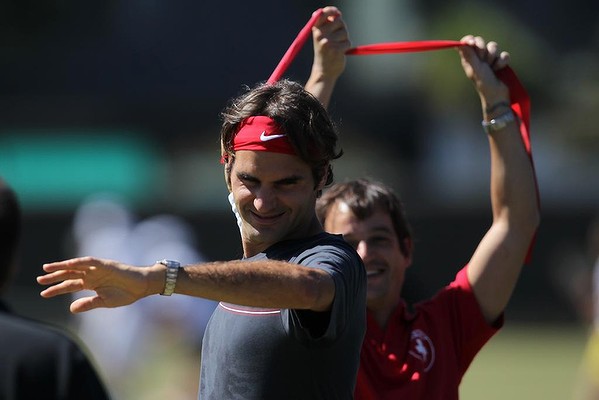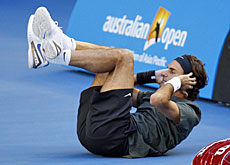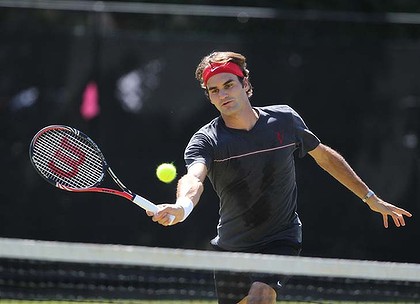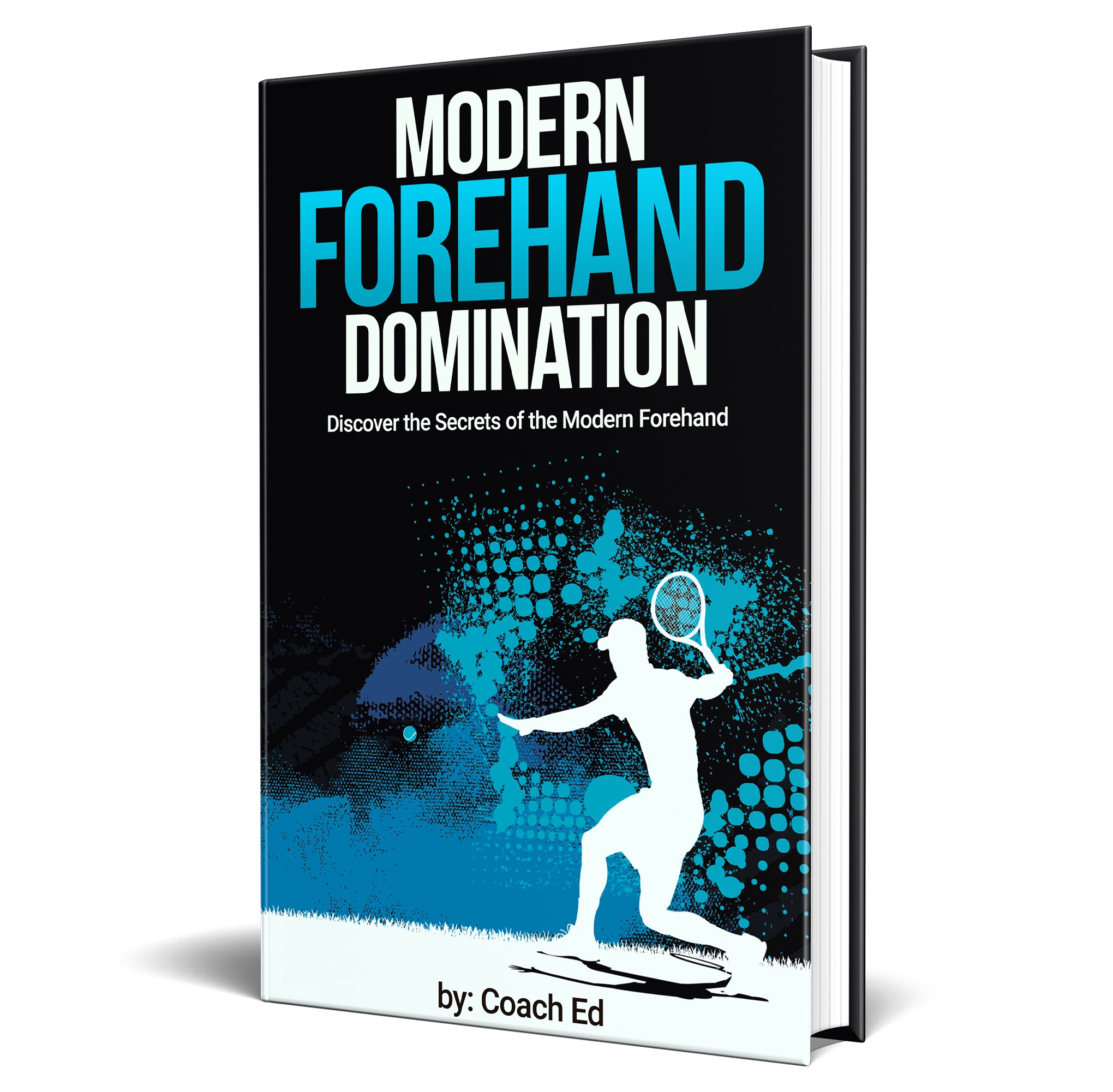Roger Federer has a classic style with no apparent weaknesses and the ability to hit any stroke with power, featuring a sublime one-handed backhand and a reliable and wicked forehand as well.
What fans might not realize as they watch Federer move around the court like a water bug is that he has spent hours and hours away from the tennis court to prepare his body for 3-, 4- and even 5-hour matches.
None of Federer’s shot-making would be possible if he did not get to the ball in the first place. How does this great champion get his body fit as a fiddle? Here are some insights into Roger Federer’s training.
Roger Federer’s training program has been monitored for more than a decade under Pierre Paganini, a strength and conditioning coach whom he met while playing as a teen. Paganini designs programs with a variety of exercises to diversify Roger Federer’s training, from weight work to footwork to sprints. Federer works out about 10 hours a week off the court in the off season, much less (if at all) when he is in the midst of a playing schedule.
Here are some typical exercises that comprise Roger Federer’s training:
Federer loves the jump rope, as many athletes do. Most of his training sessions include several minutes with the rope. He skips in a fairly leisurely fashion as a warm-up, then does his jumps at twice the normal speed. The jump rope is a great fitness tool and a key part of Roger Federer’s training routine. It builds both cardiovascular fitness and agility, two of the main weapons that any top tennis player needs in his arsenal, including you. Get a good, solid rope and use it often, alternating such work with core drills as well.
A Brief Warm Up in the Federer Training Program


As another warm-up, Roger Federer’s training routine consists of doing several jogging steps that tax different muscles, such as butt kicks, the running motion where the heel must touch the buttock with each step as a player advances from the net to the baseline and back again. This can be an excellent warm-up for you, too, before a match to get the leg muscles going.
The Roger Federer training regimen also includes a set or two of shuffles across the court, moving as quickly as he can from sideline to sideline.
This movement is absolutely crucial in tennis, as any player knows, and is not often used in other sports (occasionally in basketball and football). Be sure to not cross your legs as you continue to warm up with this shuffle step from side to side.
Upper Body Component of Roger Federer’s Training


Now that he has warmed up his legs, Roger Federer’s training aims to work out other parts of his body, including his upper body, so key to sound tennis strokes. The core is also helped by his next exercise: the medicine ball toss. You will need a partner for this movement as you stand across from your friend about halfway back in the service box on the singles sideline. Fling the medicine ball back and forth at chest level as you again shuffle from sideline to sideline.
Go from side to side three times, then take a break.
Another medicine ball workout calls for the player to throw the ball at a small trampoline-type device, raising the ball above the head and throwing straight on from above the shoulders. This movement does all sorts of great things for the shoulders and core as the ball is both thrown and caught. It also does not require a partner, obviously. The medicine ball is another key tool in Roger Federer’s training (Rafael Nadal’s as well, by the way). It has a definite outsized effect on core muscles and adds a little fun to the workout.
Non-Racket Drills in the Roger Federer Training Program
Another major part of Roger Federer’s training workouts are various exercises with the ball and racquet, of course, in non-playing situations. One exercise that he has used in the past is to have someone throw three balls to him from about 10 feet away. The challenge is to hit all three balls, one at a time, before they bounce a second time. This exercise does wonders for reaction time. Another little routine is kind of like the baseball game of “Pepper.”
In this drill, someone throws a softly bounced ball to Federer, about six feet away. Federer then has to catch the ball with either hand and softly bounce it back to his partner. The game gets more interesting when speed becomes a main goal of the drill. This movement helps with hand-eye coordination and anticipation, two more crucial pieces in the tennis player’s tool kit.
Cone Drills in the Federer Training Program


A cone drill that can be found in Roger Federer’s training is done by placing three of them in a triangle about four feet apart from one another, just inside the baseline.
Federer then moves around each cone as he swings forehand and backhand strokes, taking one stroke each time he goes around a cone in a zig-zag manner, circling each cone.
This brings together the essential ground stroke movements with the accompanying footwork. Eventually, a player does both without having to think about either one; Federer does this on a regular basis now after many hours of such training.
Exercise Bands as part of Roger Federer’s Training Program


The Roger Federer training routine has also been known to incorporate exercise bands into workouts, and they can serve a great number of functions, making them another key tool in the tennis training regimen. Federer sometimes places a band between his legs while practicing ground strokes so that each leg movement creates some resistance, strengthening the muscles used in a typical match.
As the band is stretched with every shot, the legs are getting stronger and stronger. When he plays with no band between his legs, he feels light and free.
Another good exercise involves placing the band around one’s waist and attaching the other end to the net. Balls are then hit to Federer both short and long, and as he races back and forward, he again is taxing his muscles in a unique way while doing familiar movements. The inexpensive rubber bands, which can be purchased at any sporting goods store, comprise another major component of Roger Federer’s training (and most top players’).
Roger Federer Training For Tennis Volleys


To help with balance, Federer also stands on a stiff mini-trampoline device and hits volleys. The trick is he does this while balancing on one leg.
When you can hit a solid volley on one leg, imagine the incredible balance that you will achieve and how you will feel when you hit a volley with both feet on the ground! It’s no wonder the Roger looks so composed at the net. You will, too.
These eight points about Roger Federer’s training have been purposely chosen because they are the types of exercises that just about anyone can do at minimal cost and with many of them not requiring a partner.
These exercises also have been chosen because they represent a good mid-point between weight room training and on-the-court playing, a nice halfway point that many tennis players like to use as they prepare for match play.
Weight Room Element of the Roger Federer Training Program
The Roger Federer training program includes an element of the weight room during the off season, doing the standard exercises for tennis players, including leg press, bench press, the fly, leg squats and bicep and tricep curls, among others. He also has a routine that includes rope skipping alternated with core work, often using plank positions to strengthen that part of the body. These exercises as part of Roger Federer’s training can be read about on many sites on the Web.
With the above group of drills you can both improve your cardiovascular fitness and your agility, as well as strengthen your leg, arm, shoulder and core muscles, so that even if you can’t play like Roger Federer, you can be nearly as fit as he is and win your next long match simply because you are in exquisite shape.
Learn to Hit a Forehand Like Roger Federer
If you want to jumpstart your forehand and play like the PROS, check out my 70+ page Tennis Ebook that will immediately show you how you can take your forehand to the next level.
The Modern Forehand Domination Ebook is guaranteed to improve your tennis technique, and increase power, topspin and accuracy of your tennis forehand!
Modern Tennis Forehand Ebook
Learn How to Hit a Forehand Like Federer, Nadal and Djokovic

